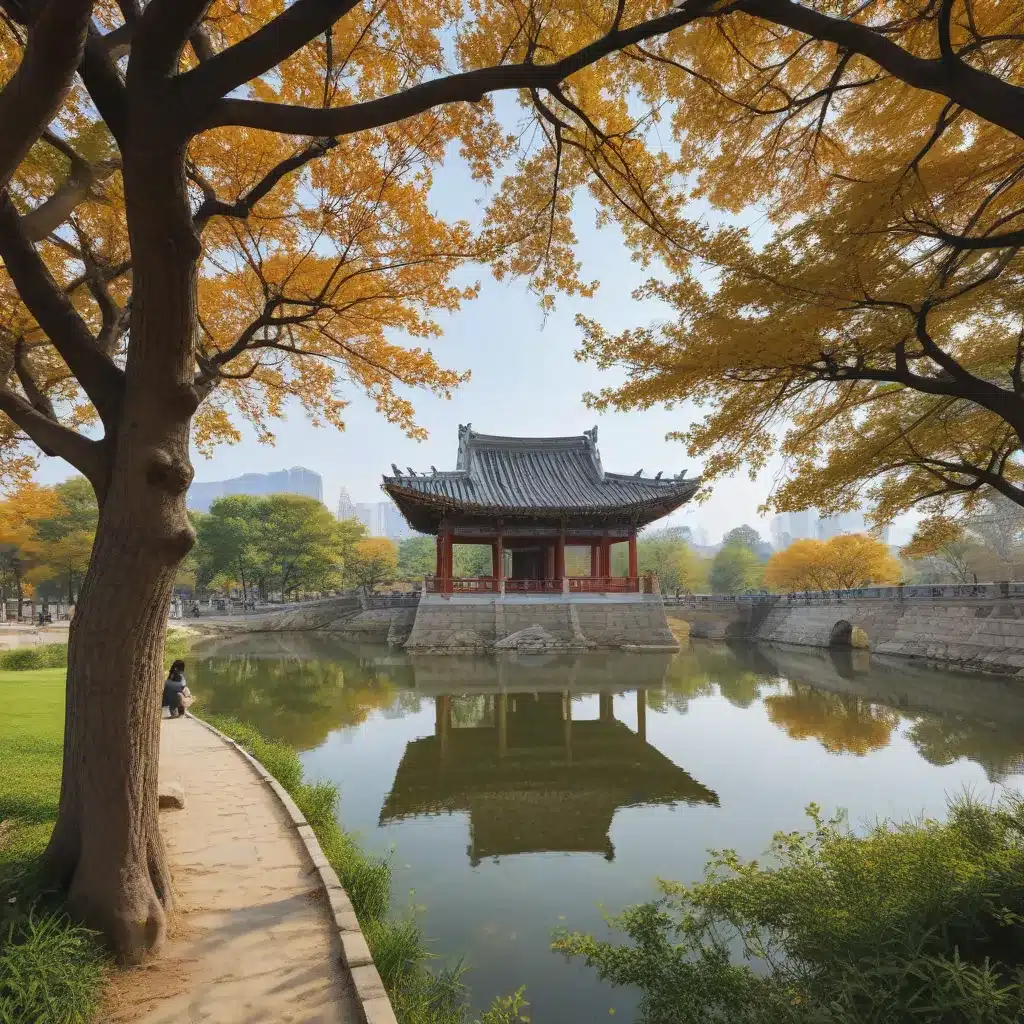
Uncovering the Hidden Gems of Seoul
As I stroll through the bustling streets of Seoul, it’s easy to get caught up in the city’s dazzling lights and pulsating energy. But today, I’m on a mission to uncover the natural wonders that lie just beneath the surface. My destination? The Secret Garden and Gyeongbokgung Palace – two of Seoul’s most enchanting and serene hideaways.
Stepping into the Secret Garden
The Secret Garden, or “Biwon” as it’s known locally, is a true oasis of tranquility in the heart of Seoul. As I pass through the unassuming entrance, it’s as if I’ve been transported to a different world – one where time seems to stand still and the hustle and bustle of the city fade into the background.
The garden’s meticulously manicured landscapes are a feast for the senses. Vibrant azaleas and delicate cherry blossoms dot the winding pathways, their petals dancing in the gentle breeze. Ornate pavilions and serene ponds dot the terrain, offering ample opportunities to pause and soak in the serenity.
One of the highlights of the Secret Garden is the Buyongjeong Pavilion, a stunning example of traditional Korean architecture. As I ascend the steps and step inside the pavilion, I’m struck by the intricate woodcarvings and the breathtaking views that stretch out before me. It’s easy to imagine the royal families of old lounging here, basking in the tranquility and natural beauty that surrounds them.
Exploring the Grandeur of Gyeongbokgung Palace
From the Secret Garden, I make my way to the nearby Gyeongbokgung Palace, the former seat of the Joseon dynasty and one of Seoul’s most iconic landmarks. As I approach the grand main gate, known as Gwanghwamun, I can’t help but be in awe of the sheer scale and grandeur of the palace.
The palace grounds are a harmonious blend of architectural masterpieces and lush, manicured landscapes. Stunning buildings like the Gyeonghoeru Pavilion and the Geunjeongjeon Hall stand as testament to the artistic and engineering prowess of the Joseon era.
One of the most captivating aspects of Gyeongbokgung Palace is the way it seamlessly integrates with the natural surroundings. The Gangwhamun Gate, for instance, perfectly frames the iconic Mount Bugaksan in the distance, creating a breathtaking visual symphony.
As I wander through the palace, I can’t help but wonder about the stories that these walls could tell. I imagine the courtly intrigues, the diplomatic negotiations, and the everyday lives of the Joseon monarchs who once called this place home.
Discovering the Hidden Histories
But the true magic of Gyeongbokgung Palace lies in the hidden histories and little-known stories that are woven into its very fabric. Take, for instance, the tale of the Geunjeongjeon Hall, the main throne room of the palace. Legend has it that the hall was designed with a hidden drainage system that allowed rainwater to be channeled away, preventing the monarch from getting their feet wet during important ceremonies.
Or how about the story of the Gyeonghoeru Pavilion, a stunning wooden structure that once served as a banquet hall for visiting dignitaries. Apparently, the pavilion was designed with a series of hidden compartments and passageways, allowing the royal family to discreetly observe and oversee the proceedings without being seen.
These little nuggets of history add a layer of mystery and intrigue to the palace, sparking the imagination and inviting visitors to delve deeper into the rich tapestry of Korea’s past.
Immersing in the Present Moment
As I continue to explore the palace grounds, I’m struck by the way the past and present seamlessly converge. Visitors from all walks of life – from school children on field trips to elderly couples strolling hand-in-hand – come together to experience the grandeur and serenity of this historic site.
I pause to watch a group of traditional dancers perform in the courtyard, their elegant movements and vibrant costumes transporting me to a bygone era. Nearby, a group of musicians play traditional Korean instruments, the haunting melodies echoing through the halls and gardens.
It’s in these moments that I truly feel connected to the rich cultural heritage of Korea. I’m not just a passive observer, but an active participant in the ongoing story of this remarkable place.
Embracing the Sights, Sounds, and Flavors
As the sun begins to dip below the horizon, I reluctantly tear myself away from the palace grounds, but not before indulging in one final treat. I make my way to a nearby street vendor, where the tantalizing aromas of Korean street food waft through the air.
I can’t resist the temptation of a steaming hot, perfectly crisp Korean fried chicken, accompanied by a refreshing glass of cold, fizzy soju. As I savor the flavors, I reflect on the day’s adventure – the serene beauty of the Secret Garden, the grandeur of Gyeongbokgung Palace, and the rich cultural tapestry that ties it all together.
It’s a perfect ending to a truly unforgettable day in Seoul, and I can’t wait to return and uncover even more of this city’s hidden gems. Who knows what other surprises and delights await?
Exploring Seoul’s Natural Wonders at Your Fingertips
If you’re planning a trip to Seoul and want to experience the city’s natural beauty and cultural heritage, be sure to visit the Secret Garden and Gyeongbokgung Palace. And if you’re looking for a comfortable and convenient home base during your stay, consider Hotel Stay Inn Seoul. Our centrally located hotel offers easy access to all of Seoul’s top attractions, as well as all the amenities you need for a truly memorable stay.
So why not start planning your Seoul adventure today? The Secret Garden and Gyeongbokgung Palace are waiting to be explored, and with Hotel Stay Inn Seoul as your home base, you’ll be able to immerse yourself in the best of Seoul’s natural beauty and cultural richness.

